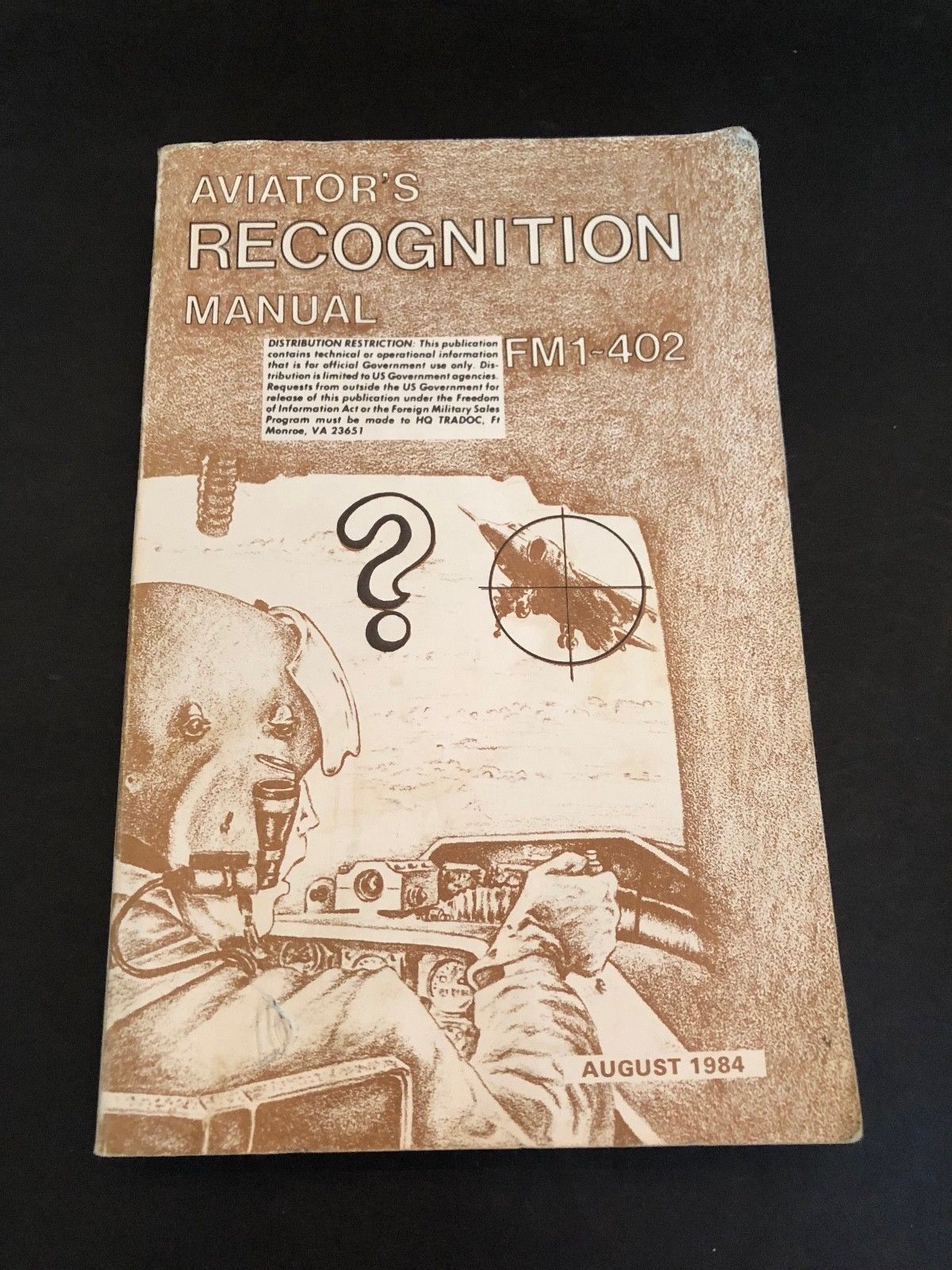 "ttyymmnn" (ttyymmnn)
"ttyymmnn" (ttyymmnn)
04/20/2018 at 12:35 • Filed to: wingspan, planelopnik history, Planelopnik
 10
10
 15
15
 "ttyymmnn" (ttyymmnn)
"ttyymmnn" (ttyymmnn)
04/20/2018 at 12:35 • Filed to: wingspan, planelopnik history, Planelopnik |  10 10
|  15 15 |
!!! UNKNOWN CONTENT TYPE !!!
Welcome to
This Date in Aviation History
, getting of you caught up on milestones, important historical events and people in aviation from April 18 through April 20.
!!! UNKNOWN CONTENT TYPE !!!
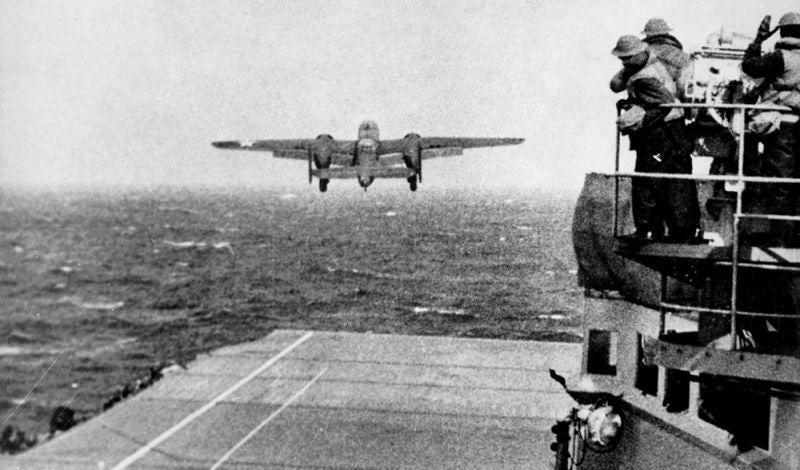
April 18, 1942 – The Doolittle Raid carries out the first attack on the Japanese homeland of WWII. When the Japanese unleashed their deadly !!!error: Indecipherable SUB-paragraph formatting!!! against American military stations in Hawaii on December 7, 1941, the United States was desperate to hit back in any way it could. In a meeting of the Joint Chiefs of Staff just two weeks after the Japanese raid, US President Franklin D. Roosevelt expressed a desire to attack Japan at the earliest possible time. Though the US was in no position to mount any sort of mission that would be equal in destruction, the boost to American morale would be immeasurable. Roosevelt also hoped to show the Japanese people that their island nation was not safe from attack, and that their leaders, who had promised to win the war, were not infallible.
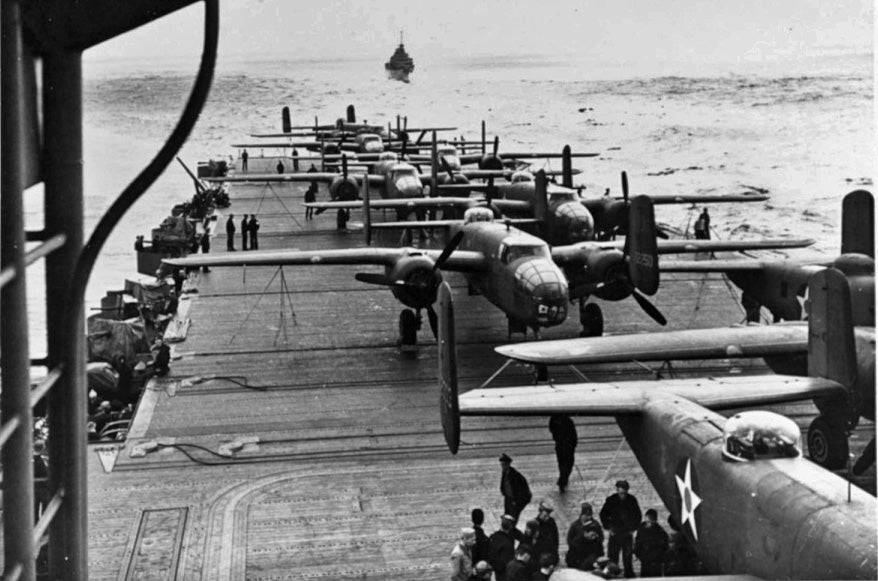
North American B-25B Mitchells tied down to the flight deck of the USS Hornet as the carrier steamed towards Japan (US Navy)
The idea for the raid was formulated by Navy Captain Francis Low, who had seen bombers practicing takeoffs from simulated carrier decks painted on the tarmac at Naval Air Station Norfolk. But in order to reach Japan, the bombers would require extreme range, since the carriers couldn’t get too close to Japan for fear of discovery. The Army Air Corps considered a handful of different aircraft for the mission, including the !!!error: Indecipherable SUB-paragraph formatting!!! , the !!!error: Indecipherable SUB-paragraph formatting!!! , and !!!error: Indecipherable SUB-paragraph formatting!!! . But none of those were as suited to the job as the !!!error: Indecipherable SUB-paragraph formatting!!! , whose high power, carrying capacity for fuel and bombs, and relatively short wingspan would be ideal for the mission, even though the Mitchell had not yet been tested in battle.
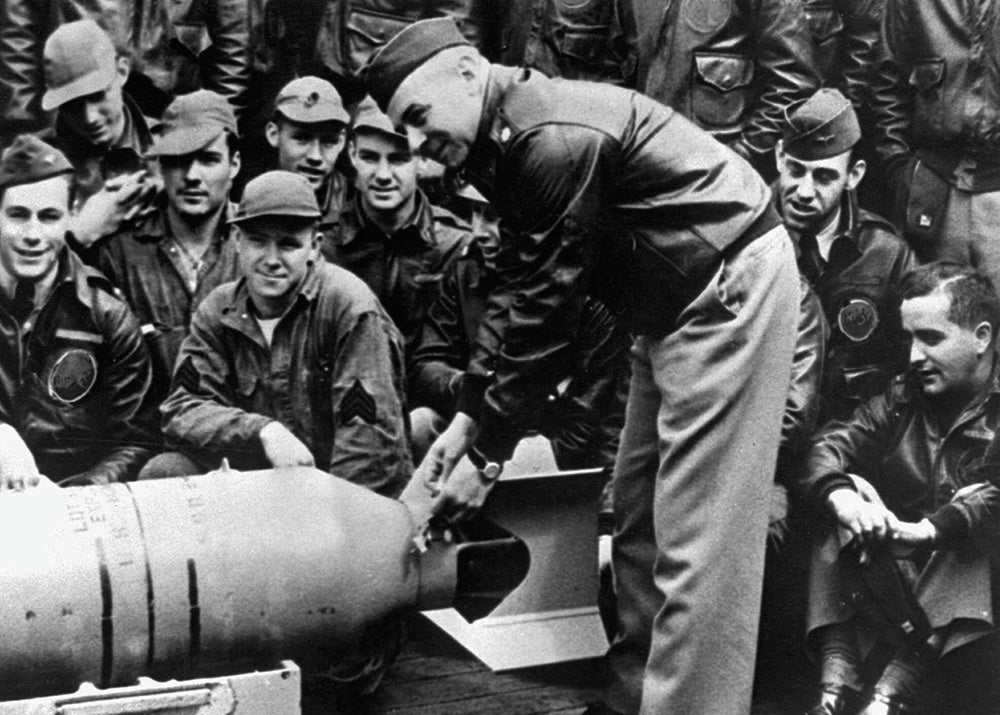
Lt. Col. Doolittle attaches Japanese friendship medals to a bomb that will be dropped on Japan while pilots and crewmen look on (US Navy)
In order to have the necessary range for the flight, significant modifications to the bombers were necessary. The lower defensive turret was removed, some radios were taken out to reduce weight, and auxiliary fuel tanks were added in the bomb bay. The secret !!!error: Indecipherable SUB-paragraph formatting!!! was removed, principally to prevent it’s falling into enemy hands. It was replaced with a homemade sight that cost just 20 cents to produce and actually proved to be quite accurate. After three weeks of intensive training, sixteen of the specially modified bombers were flown by their crews to NAS Alameda and loaded on board !!!error: Indecipherable SUB-paragraph formatting!!! (CV-8) for the journey west. Upon reaching Hawaii, Hornet was joined by the !!!error: Indecipherable SUB-paragraph formatting!!! (CV-6) which would provide fighter cover for the mission since all of Hornet’s fighters were stowed belowdecks to accommodate the bombers. Each of the B-25s carried four munitions: three 500-pound bombs and one 500-pound incendiary bomb. The crews affixed Japanese “friendship” medals to some of the bombs, decorations that had been awarded to US servicemen before the war. Doolittle’s men saw fit to return them, given the current state of hostilities.
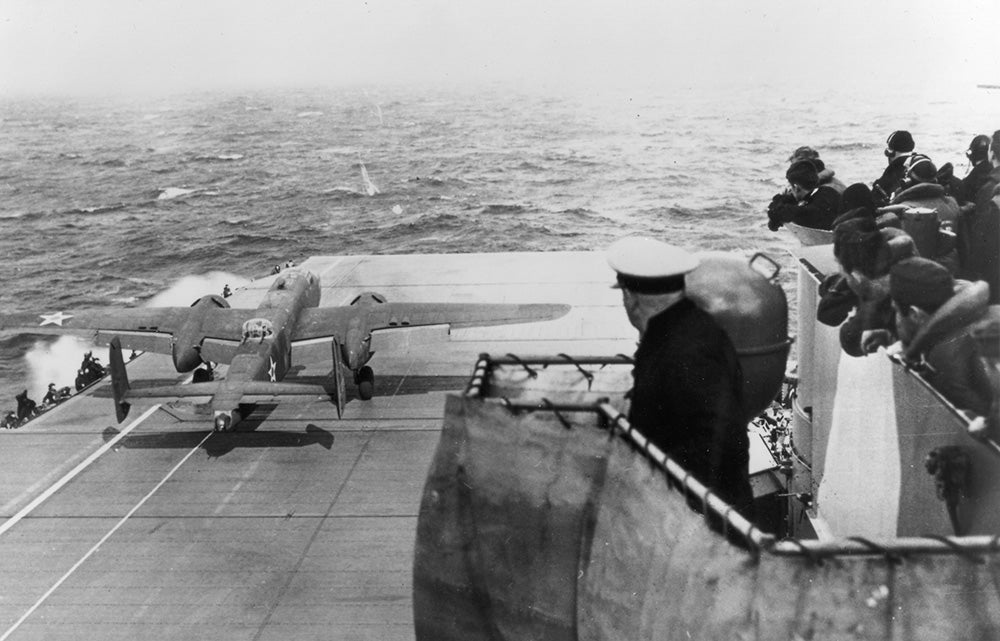 !!!CAPTION ERROR: MAY BE MULTI-LINE OR CONTAIN LINK!!!
!!!CAPTION ERROR: MAY BE MULTI-LINE OR CONTAIN LINK!!!
On the morning of April 18, the fleet was spotted by a Japanese patrol boat roughly 433 miles from Japan. The cruiser !!!error: Indecipherable SUB-paragraph formatting!!! (CL-43) quickly sank the boat but, fearing that its crew had radioed a warning to Japan, Doolittle decided to take off earlier than originally planned. Following guidelines painted on the flight deck to make sure the bombers’ wings cleared the carrier’s island, the bombers struggled into the air and turned towards Japan. Though it was the first time the pilots had actually taken off from a carrier, the takeoffs proceeded without incident. The bombers arrived over Japan at low level at about noon local time and dropped their bombs and strafed ground targets. None of the bombers was seriously hit by antiaircraft fire, and defensive gunners managed to shoot down at least three Japanese fighters. After dropping their bombs, the crews continued westward, across the Yellow Sea and into China. Without enough fuel to reach their intended landing points, the crews all bailed out or crash landed. One crew flew to Russia.
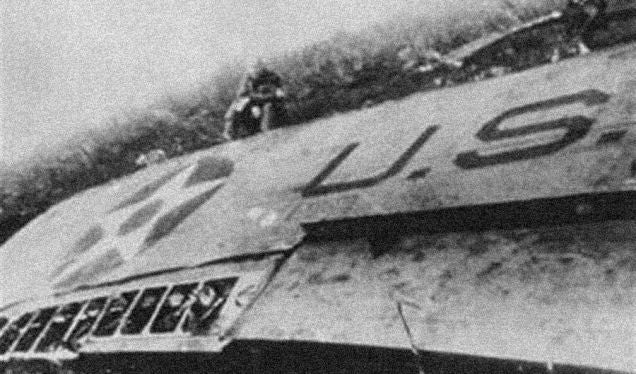
A despondent Doolittle sits by the wreckage of his bomber somewhere in China. Doolittle believed he and his men would be court-martialed for failing to complete the mission safely. Instead, they were all decorated and Doolittle was promoted to the rank of brigadier general. (Author unknown)
Of the 80 airmen who took part in the mission, three were killed in action and eight were captured by the Japanese. Three of the POWs were executed, one died in captivity, and the other four were eventually rescued in August 1945. The rest of the airmen were rescued by Chinese civilians and handed over to the Chinese government, though many of the civilians were executed by the Japanese in a fit of revenge for helping the Americans. As expected, the raid caused relatively insignificant damage, but it gave the American public the first positive news of the war. All the surviving members of the raid were awarded the Distinguished Flying Cross, those killed or wounded received the Purple Heart, and Doolittle was promoted to brigadier general and awarded the Congressional Medal of Honor. Though little material damage was caused by the raid, the fact that medium-range bombers had attacked Japan hastened Japanese plans to capture !!!error: Indecipherable SUB-paragraph formatting!!! , bringing about the pivotal !!!error: Indecipherable SUB-paragraph formatting!!! that ultimately shifted the balance of power in the Pacific over to the Americans.
!!! UNKNOWN CONTENT TYPE !!!
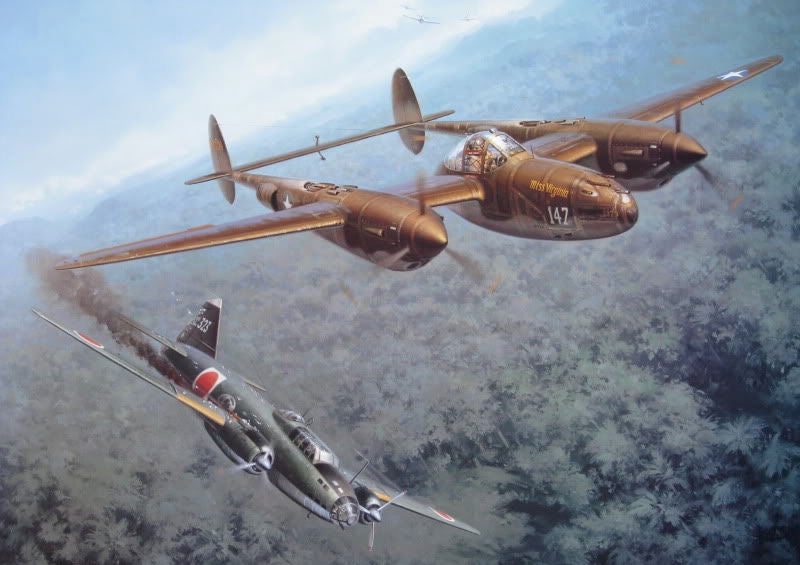
(Artist unknown)
April 18, 1943 – The death of Japanese general Isoroku Yamamoto. In military terms, “decapitation” is the tactic of killing the commander of an army in hopes of rendering the fighting force ineffective, and it has been discussed my military theorists as far back as !!!error: Indecipherable SUB-paragraph formatting!!! and !!!error: Indecipherable SUB-paragraph formatting!!! . If you remove the commander of an army, as the theory goes, you could speed the ultimate victory in the conflict or, at the least, sow confusion to gain a tactical edge. !!!error: Indecipherable SUB-paragraph formatting!!! was the commander-in-chief of the Japanese !!!error: Indecipherable SUB-paragraph formatting!!! during WWII and the mastermind behind the Japanese !!!error: Indecipherable SUB-paragraph formatting!!! . So, when the US military learned that Yamamoto would be making an airborne tour of Japanese military bases, they leapt at the opportunity to eliminate Japan’s leading military strategist. There can be little doubt that this was not just a decapitation mission, but also retribution for Pearl Harbor, which explains why the mission was codenamed Operation Vengeance .
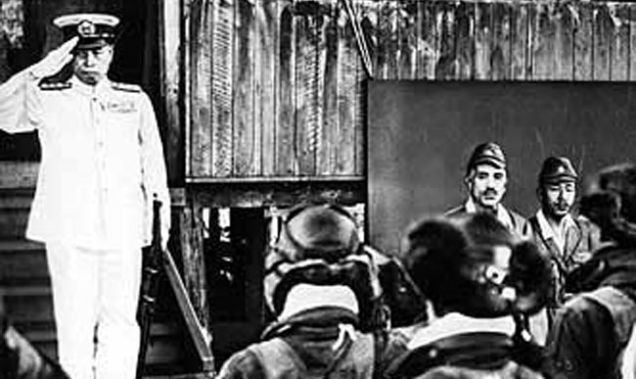
The last photo of Admiral Isoroku Yamamoto, taken shortly before his death
On April 14, 1943, US Navy listening stations intercepted coded messages that were sent to Japanese bases in the Solomon Islands and New Guinea alerting the personnel to the planned arrival of Admiral Yamamoto as part of a morale-boosting inspection tour following the Japanese loss of Guadalcanal. The messages were decoded by Navy cryptographers (one of whom was !!!error: Indecipherable SUB-paragraph formatting!!! , a future US Supreme Court Justice) who were able to determine the exact timetable and location for Yamamoto’s tour. The information was relayed to Washington, where President Roosevelt ordered the Secretary of the Navy to “Get Yamamoto.” The mission was authorized on April 17.
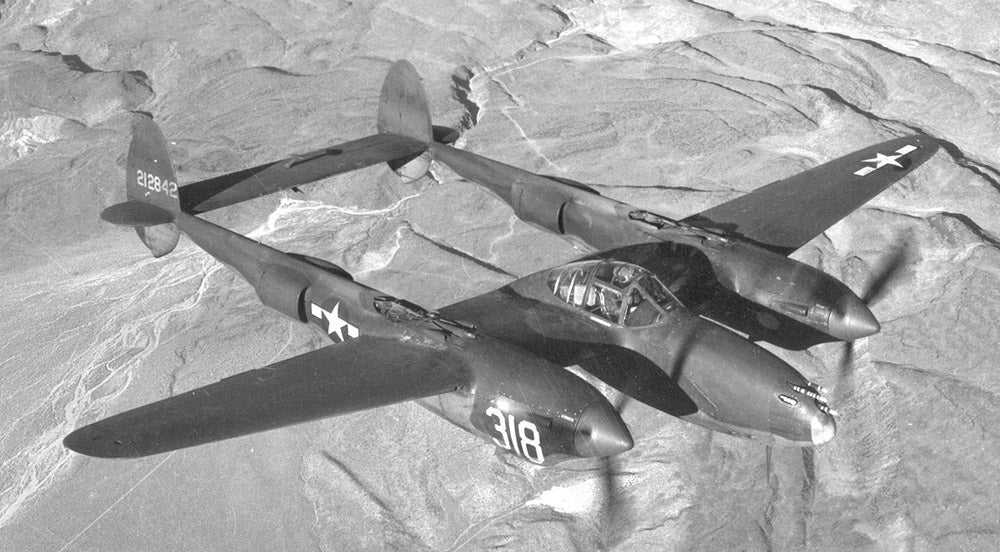
A Lockheed P-38G Lightning. The Lightning was chosen for the mission for its long range and heavy firepower. (US Air Force)
Now that the US knew where Yamamoto would be, they needed a way to get to him. Navy fighters such as the !!!error: Indecipherable SUB-paragraph formatting!!! and !!!error: Indecipherable SUB-paragraph formatting!!! didn’t have the necessary range to reach the target from Guadalcanal. So the mission fell to the US Army Air Force’s !!!error: Indecipherable SUB-paragraph formatting!!! and their !!!error: Indecipherable SUB-paragraph formatting!!! . To complete the 1,000 mile flight, extra fuel tanks and drop tanks were fitted to the aircraft. To make sure they didn’t miss their chance, the Americans sent a total of eighteen Lightnings (two returned due to mechanical problems) to intercept the two !!!error: Indecipherable SUB-paragraph formatting!!! “Betty” bombers that carried Yamamoto and his staff. Four aircraft were designated as the “killers,” while the other P-38s would provide cover and fight off the six !!!error: Indecipherable SUB-paragraph formatting!!! fighters that were escorting Yamamoto. When Yamamoto’s flight was located, the Americans turned to the attack and quickly shot down the first bomber, which crashed in the jungle. The second Betty tried to flee out to sea, but it too was shot down into the ocean. The Americans also claimed two Zero fighters shot down, but those were not confirmed.
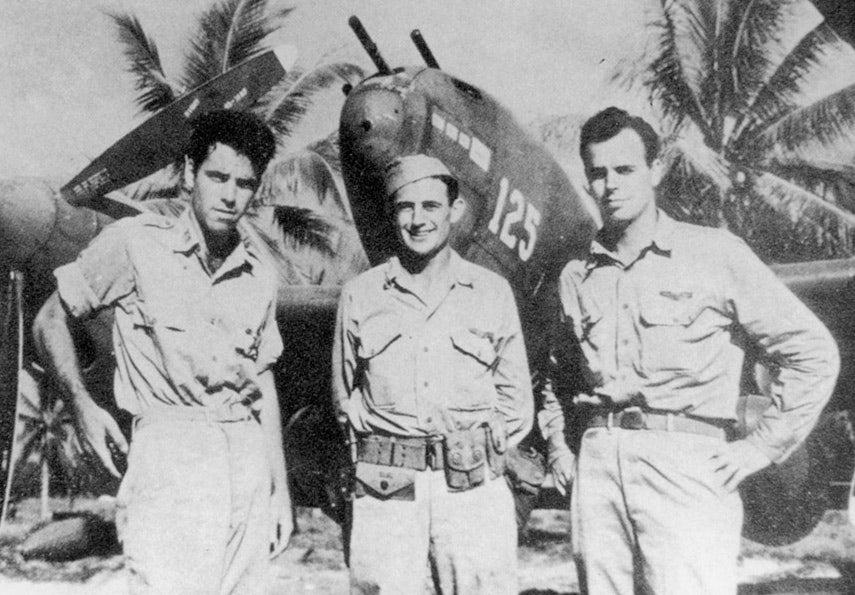
Capt. Thomas Lanphier, Jr., Lt. Besby Holmes and Lt. Rex Barber, three of the four pilots assigned with shooting down Yamamoto’s airplane. The third pilot, Lt. Raymond Hine, was lost during the mission and never found. (National Archive)
The next day, a Japanese search and rescue party found the wreckage of Yamamoto’s plane in the jungle. A post-mortem examination determined that Yamamoto died not in the crash but from two bullets, one of which hit him in the head. To this day, though, there remains much debate—and acrimony—over who actually shot down Yamamoto’s plane. Initially, Capt. !!!error: Indecipherable SUB-paragraph formatting!!! was given credit. But differing accounts led to a counterclaim by Lt. !!!error: Indecipherable SUB-paragraph formatting!!! , and to this day, the Navy officially gives them each half a credit for the shoot down. With Yamamoto’s death, the Japanese had lost one of their most capable military leaders, and the Americans gained yet another significant morale boost, one which came exactly one year to the day after the audacious Doolittle Raid on Japan.
!!! UNKNOWN CONTENT TYPE !!!
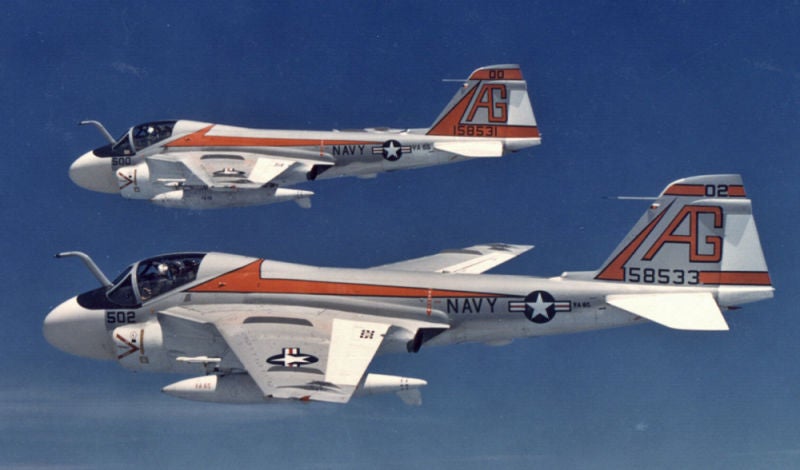
(US Navy)
April 19, 1960 – The First flight of the Grumman A-6 Intruder. During WWII, aircraft of the US Navy mainly focused their efforts on Japanese shipping and coastal targets. But during the Korean War, which followed quickly on the heels of the Second World War, Navy and US Marine Corps pilots found themselves flying the majority of their sorties against targets on land, far away from their carrier bases. Most of those missions were carried out by the remarkable !!!error: Indecipherable SUB-paragraph formatting!!! and !!!error: Indecipherable SUB-paragraph formatting!!! , but the Navy decided in 1955 to develop a jet-powered aircraft that could perform the same ground attack mission but carry a significantly larger payload. They issued requirements for an all-weather, jet-powered tactical strike aircraft, and no less than eleven designs were submitted by Bell, Boeing, Douglas, Lockheed, Martin, North American, Vought and Grumman. Grumman already had a long history and solid reputation for building naval aircraft and, on January 2, 1958, the Navy awarded a contract for development of an aircraft that Grumman had designated the G-128.
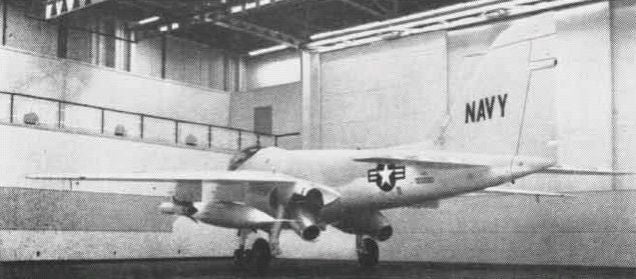
The A-6 prototype. Note the swiveling jet nozzles. (US Navy)
Unlike most aircraft of its size, the Intruder accommodated its two-man crew in a side-by-side configuration, more like a traditional bomber, rather than in tandem like a fighter. This arrangement allowed for better communication between the pilot and bombardier/navigator (B/N) and, in practice, the B/N often became as much a copilot as a weapons officer, helping the pilot monitor aircraft systems and radios. The large canopy covering the wide cockpit provided excellent visibility, and the bulbous nose section supplied ample room for electronic equipment. The first Intruders were fitted with the Digital Integrated Attack/Navigation Equipment (DIANE), a system that provided the crew with a digital display of both targets and terrain features and allowed attack missions in day or night, all weather, or other low-visibility conditions. The A-6's large wing was designed for both low-speed maneuverability and large weapons load, and the Intruder was capable of carrying as much as 15,000 pounds of munitions or a single nuclear weapon. Later variants were capable of carrying up to 18,000 pounds of stores. Power for the Intruder was provided by a pair of !!!error: Indecipherable SUB-paragraph formatting!!! non-afterburning turbojets which propelled the Intruder to a top speed of 685 mph in a clean configuration and a range of just under 2,000 miles fully loaded with weapons. To get all that armament off the deck, the original prototype of the Intruder was fitted with jet nozzles that could be swiveled downward to provide extra lift on takeoff. This system was eventually dropped, but the engine nozzles of production aircraft were still given a slight downwards deflection.
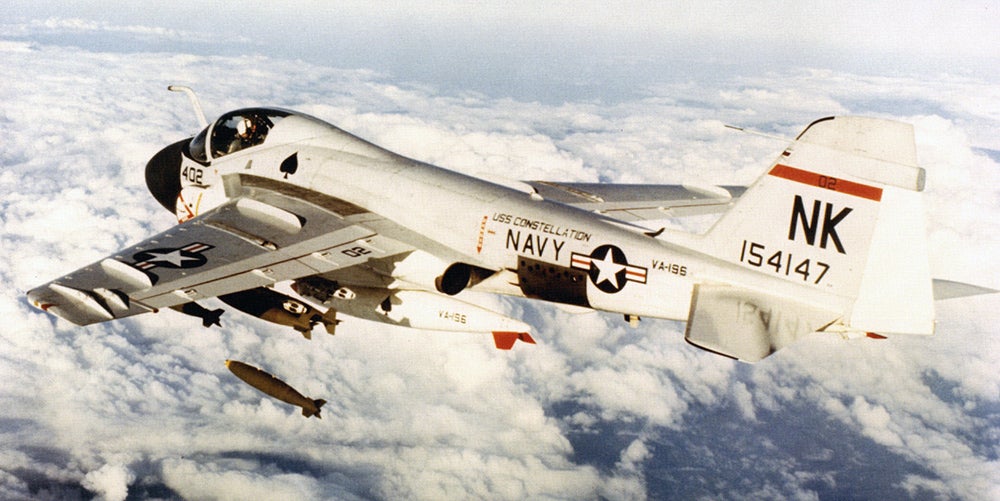
A US Navy Grumman A-6A Intruder from Attack Squadron 196 (VA-196) “Main Battery” drops Mk 82 bombs during a combat mission over South Vietnam in 1968. (US Navy)
The Intruder entered service with the Navy and Marine Corps in 1963 and served as the primary all-weather attack platform following American entry into the Vietnam War. The A-6 proved to be a rugged aircraft that could absorb significant punishment and still return its crew to the carrier, reaffirming the “Iron Works” nickname that Grumman earned during WWII. Operating from carriers off the coast of Vietnam, Intruder crews flew 35,000 sorties during the war, with the loss of 69 aircraft to enemy fire. The A-6's excellent low-level maneuverability often allowed the pilot to out-turn incoming surface-to-air missiles, and the majority of Intruder losses were attributed to anti-aircraft artillery. Following Vietnam, the Intruder saw action in support of the !!!error: Indecipherable SUB-paragraph formatting!!! in 1983 and over Libya in 1986. The Intruder flew its final combat missions during the Gulf War of 1990-1991, flying 4,700 sorties against Iraqi targets. Intruders also served as aerial refueling platforms designated KA-6D.
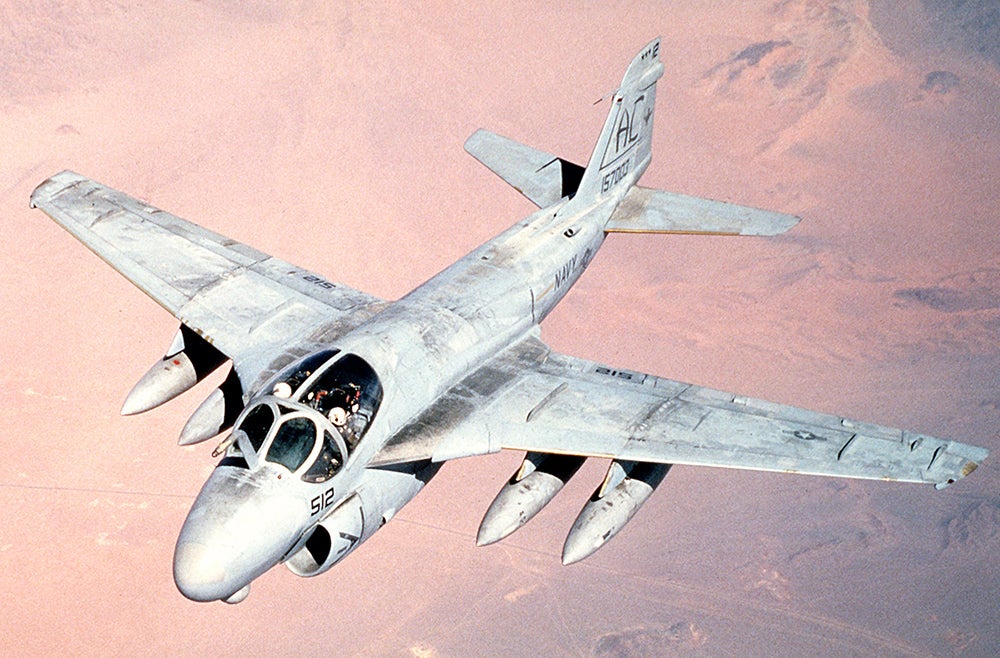
A US Navy A-6E Intruder from attack squadron VA-75 “Sunday Punchers” flies over the desert Operation Desert Storm in 1991. (US Navy)
In the mid-1980s, Grumman proposed a significantly upgraded Intruder, the A-6F Intruder II, which would have replaced the original turbojets with !!!error: Indecipherable SUB-paragraph formatting!!! turbofans, the same engine flown in the !!!error: Indecipherable SUB-paragraph formatting!!! . The radar also would have received a significant upgrade, and weapons load would be increased. However, the Navy passed on the Intruder II, focusing instead on the development of the stealthy !!!error: Indecipherable SUB-paragraph formatting!!! , which was slated as the A-6's replacement. But when cost overruns led to the cancelation of the A-12, the Navy was left without a dedicated attack aircraft. After nearly 35 years of service, the A-6 was retired in 1997 following a production run of nearly 700 aircraft, and its mission was briefly passed to specially equipped !!!error: Indecipherable SUB-paragraph formatting!!! . The attack mission is now carried out by the multirole and !!!error: Indecipherable SUB-paragraph formatting!!! , and the !!!error: Indecipherable SUB-paragraph formatting!!! , which is expected to make its first deployment in 2020.
!!! UNKNOWN CONTENT TYPE !!!
Short Takeoff
!!! UNKNOWN CONTENT TYPE !!!
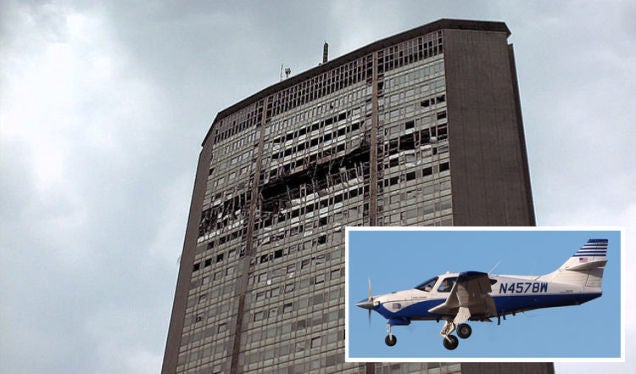 !!!CAPTION ERROR: MAY BE MULTI-LINE OR CONTAIN LINK!!!
!!!CAPTION ERROR: MAY BE MULTI-LINE OR CONTAIN LINK!!!
April 18, 2002 – A small aircraft crashes into Pirelli Tower in Milan, Italy. Completed in 1958 to house the offices of the eponymous Italian tire company, Pirelli Tower was the tallest building in Italy until 1995 and the architectural inspiration for the !!!error: Indecipherable SUB-paragraph formatting!!! in New York City. While flying a planned route from Locarno to Milan, pilot Gino Fasulo, at the controls of a !!!error: Indecipherable SUB-paragraph formatting!!! , was preparing to make an emergency landing while low on fuel when, perhaps while attempting to manually lower the aircraft’s landing gear, he veered off course and crashed into the 25th floor of the tower. The crash killed the pilot along with four people inside the building, set fire to four floors, and initially raised fears of another terrorist attack similar to those carried out on !!!error: Indecipherable SUB-paragraph formatting!!! in the US.
!!! UNKNOWN CONTENT TYPE !!!
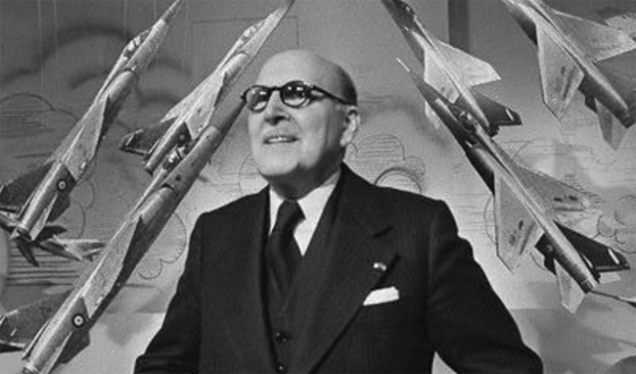
(Author unknown)
April 18, 1986 – The death of Marcel Dassault.
Born Marcel Bloch on January 22, 1892, Dassault made his first contribution to aviation by designing an aircraft propeller during WWI, then founded his own aircraft manufacturing company, the
Société des Avions Marcel Bloch
. Of Jewish parentage, Bloch took the name Dassault, deriving it from
char d’assaut
, the French work for
battle tank
. During WWII, Dassault refused to collaborate with the
!!!error: Indecipherable SUB-paragraph formatting!!!
, a French company created during the German occupation of France, so he was sent to the
!!!error: Indecipherable SUB-paragraph formatting!!!
concentration camp until its liberation in 1945. In 1947, his company became the
Société des Avions Marcel Dassault,
which designed the
!!!error: Indecipherable SUB-paragraph formatting!!!
, the first French jet fighter to enter production.
!!!error: Indecipherable SUB-paragraph formatting!!!
is now the premiere manufacturer of military, business and regional jets in France.
!!! UNKNOWN CONTENT TYPE !!!
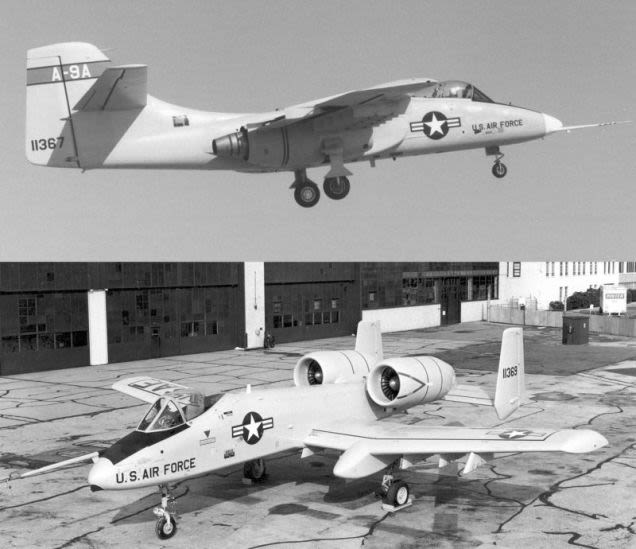
(US Air Force)
April 18, 1973 – The Fairchild YA-10 is chosen over the Northrop YA-9. In 1966, the US Air Force issued a request for a low-cost attack aircraft, one that would have long loiter time, good low-speed maneuverability, tremendous firepower and excellent survivability. Both the YA-9 and YA-10 were built around the !!!error: Indecipherable SUB-paragraph formatting!!! 30mm rotary cannon. Northrop offered the !!!error: Indecipherable SUB-paragraph formatting!!! , while Fairchild Republic offered the YA-10. After a fly off between the two prototypes, the Air Force selected the YA-10, which would become known as the !!!error: Indecipherable SUB-paragraph formatting!!! . The YA-9 prototypes were given to NASA for testing, but were quickly retired.
!!! UNKNOWN CONTENT TYPE !!!
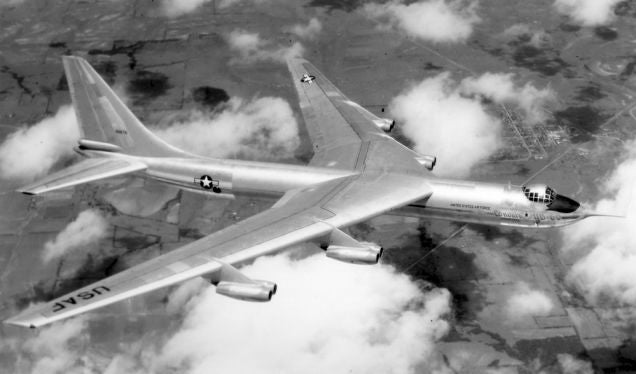
(US Air Force)
April 18, 1952 – The first flight of the Convair YB-60, a jet powered, swept-wing version of the !!!error: Indecipherable SUB-paragraph formatting!!! . With a 72% parts commonality with the B-36, it was considerably cheaper to produce than the !!!error: Indecipherable SUB-paragraph formatting!!! , its unofficial competitor. However, the YB-60 was 100 mph slower than the B-52, and had severe handling problems. While it could carry a heavier bomb load, the Air Force didn’t see that as a major factor to favor it over the B-52. The YB-60 test program was canceled in January 1953 after just 66 hours of flight testing, and both the flying prototype and one unfinished prototype were scrapped.
!!! UNKNOWN CONTENT TYPE !!!
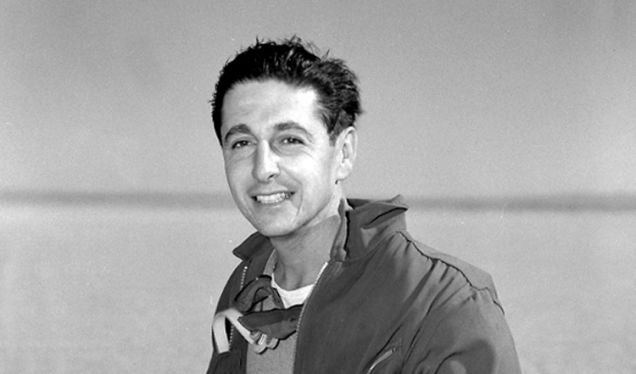
(NASA)
April 19, 2006 – The death of Scott Crossfield. Crossfield was born on October 2, 1921 and served in the US Navy as a flight instructor and fighter pilot during WWII. After obtaining a degree in aeronautical engineering, Crossfield went to work for the !!!error: Indecipherable SUB-paragraph formatting!!! (NACA, later NASA), where he took part in test flights of nearly every aircraft under development at the !!!error: Indecipherable SUB-paragraph formatting!!! , including the !!!error: Indecipherable SUB-paragraph formatting!!! , !!!error: Indecipherable SUB-paragraph formatting!!! , !!!error: Indecipherable SUB-paragraph formatting!!! , !!!error: Indecipherable SUB-paragraph formatting!!! , !!!error: Indecipherable SUB-paragraph formatting!!! . Crossfield also became the first pilot ever to exceed Mach 2 while flying the !!!error: Indecipherable SUB-paragraph formatting!!! . As the chief test pilot for North American Aviation, Crossfield played a major role in the development of the !!!error: Indecipherable SUB-paragraph formatting!!! , performing the first glide flight of the aircraft on June 8, 1959 and making a total of 14 test flights. After leaving North American, Crossfield worked as an executive for !!!error: Indecipherable SUB-paragraph formatting!!! and !!!error: Indecipherable SUB-paragraph formatting!!! , and died at the age of 84 in the crash of his !!!error: Indecipherable SUB-paragraph formatting!!! while flying in adverse weather conditions.
!!! UNKNOWN CONTENT TYPE !!!
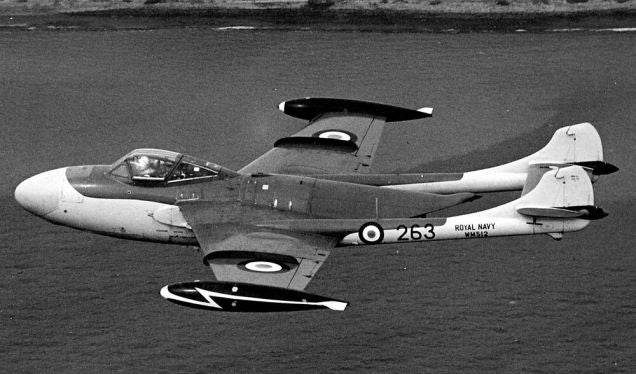
(Kookaburra2011)
April 19, 1951 – The first flight of the de Havilland Sea Venom,
a carrier-based all-weather interceptor developed from the
!!!error: Indecipherable SUB-paragraph formatting!!!
two-seat night fighter. The Sea Venom was fitted with folding wings, an arrestor hook, and strengthened landing gear, and the canopy was modified to allow underwater ejection. The production model was fitted with a single
!!!error: Indecipherable SUB-paragraph formatting!!!
turbojet which gave the Sea Venom a top speed of 575 mph, and it was armed with four
!!!error: Indecipherable SUB-paragraph formatting!!!
20mm cannons and a combination of rockets and bombs. The Sea Venom saw action in the
!!!error: Indecipherable SUB-paragraph formatting!!!
of 1956, as well as during other conflicts in the Middle East before being replaced by the
!!!error: Indecipherable SUB-paragraph formatting!!!
starting in 1959. It was retired by 1970.
!!! UNKNOWN CONTENT TYPE !!!
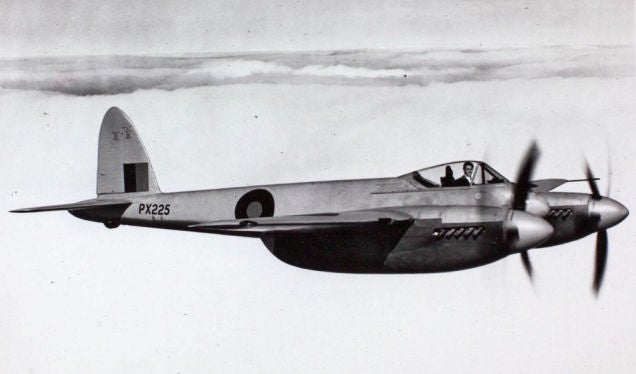
(San Diego Air and Space Museum)
April 19, 1944 – The first flight of the de Havilland Hornet,
a twin-engined fighter that was developed from the larger
!!!error: Indecipherable SUB-paragraph formatting!!!
, though it was an entirely new design. Like the Mosquito, the Hornet used wooden laminate construction to save weight, but was powered by a pair of
!!!error: Indecipherable SUB-paragraph formatting!!!
“slimline” 12-cylinder engines which provided a top speed of 475 mph, making it one of the fastest propeller fighters ever built. Though it came too late to serve in WWII, the Hornet was flown as a strike fighter during the
!!!error: Indecipherable SUB-paragraph formatting!!!
, and set numerous speed records at air races. A navalized variant, the Sea Hornet, was also developed. A total of 383 Hornets were built from 1945-1950, and the type was retired in 1956.
!!! UNKNOWN CONTENT TYPE !!!
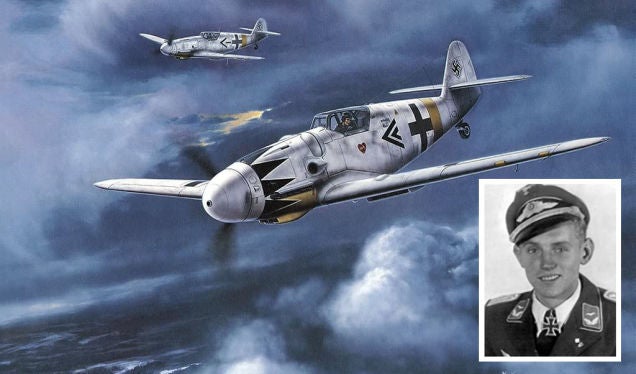
(Illustration by Jerry Crandall)
April 19, 1922 – The birth of Erich Hartmann, the most successful fighter pilot in history with 352 victories to his credit, all but seven coming against Russian aircraft. Over the course of 1,404 sorties, Hartman, known as the Blond Knight, was never shot down or forced down by enemy fire, though he did crash land 14 times, all due to mechanical problems or damage caused by the debris from aircraft he had dispatched. Following the war, Hartmann spent 10 years in Soviet prison camps before his release in 1955, and the following year he joined the newly-formed West German Luftwaffe as the first commander of !!!error: Indecipherable SUB-paragraph formatting!!! , named after !!!error: Indecipherable SUB-paragraph formatting!!! , better known as the Red Baron. Hartmann resigned from the Luftwaffe in 1970 over his opposition to the Luftwaffe’s adoption of the !!!error: Indecipherable SUB-paragraph formatting!!! , and died of natural causes in 1993.
!!! UNKNOWN CONTENT TYPE !!!
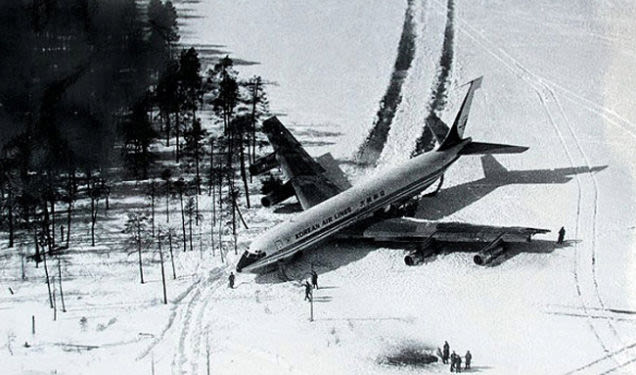 !!!CAPTION ERROR: MAY BE MULTI-LINE OR CONTAIN LINK!!!
!!!CAPTION ERROR: MAY BE MULTI-LINE OR CONTAIN LINK!!!
April 20, 1978 – Korean Air Lines Flight 902 is shot down by Russian fighters.
On a flight from Paris to Anchorage, Alaska, the crew of the KAL
!!!error: Indecipherable SUB-paragraph formatting!!!
(HL7429) made an error in calculating
!!!error: Indecipherable SUB-paragraph formatting!!!
as they neared the North Pole and mistakenly turned back towards Russia. Russian fighter pilots initially identified the aircraft as a
!!!error: Indecipherable SUB-paragraph formatting!!!
reconnaissance plane before realizing it was a civilian airliner. The Russians claimed that the KAL crew ignored attempts at communication, and the order was given to shoot the plane down. One missile struck the airliner’s wing, and the pilots made a crash landing in Russia on a frozen lake near the Finnish border. Two passengers died, and the remaining passengers and crew were detained for two days before being released. The Russian government billed South Korea $100,000 for expenses related to the care of the passengers.
!!! UNKNOWN CONTENT TYPE !!!
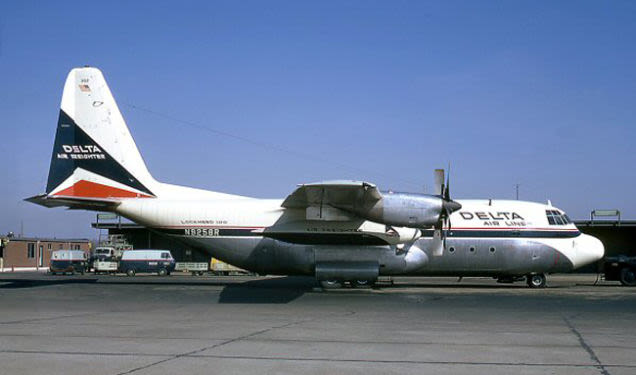 !!!CAPTION ERROR: MAY BE MULTI-LINE OR CONTAIN LINK!!!
!!!CAPTION ERROR: MAY BE MULTI-LINE OR CONTAIN LINK!!!
April 20, 1964 – The first flight of the Lockheed L-100 Hercules,
the civilian variant of the famous military cargo aircraft. The civilian Hercules arose in 1959 with an order from
!!!error: Indecipherable SUB-paragraph formatting!!!
for 12 of Lockheed’s planned GL-207 Super Hercules, but that project was eventually canceled. Instead, Lockheed chose to develop a variant of the C-130E, producing it in three lengths designated L-100, L-100-20 and L-100-30. A total of 114 of all types were completed by 1992 when production ended. Lockheed plans to further upgrade the L-100 by using the modernized
!!!error: Indecipherable SUB-paragraph formatting!!!
to produce the
!!!error: Indecipherable SUB-paragraph formatting!!!
, which took its maiden flight on May 25, 2017.
!!! UNKNOWN CONTENT TYPE !!!
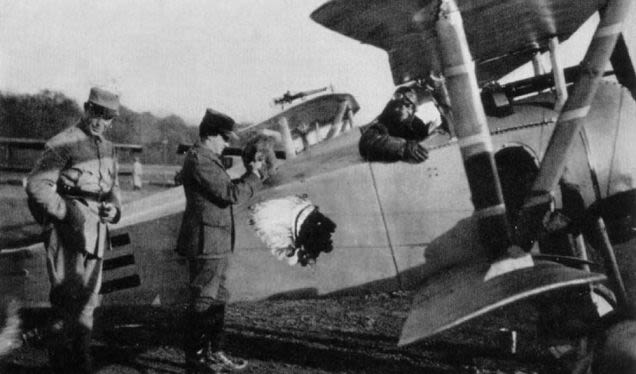
(Author unknown)
April 20, 1916 – The Lafayette Escadrille , a squadron of American fighter pilots flying for France in WWI, is deployed. Prior to America’s entry into WWI, US pilots went to Europe to fight for England and France. Named in honor of the !!!error: Indecipherable SUB-paragraph formatting!!! , who fought for the United States in the Revolutionary War, the squadron was originally called the Escadrille Américaine , wore French uniforms, and had French commanders. With so many Americans arriving in France to fight, a larger group was formed, the !!!error: Indecipherable SUB-paragraph formatting!!! , and the Lafayette Escadrille was officially disbanded on February 8, 1918. Some of its members transferred to American air units, while others trained incoming US pilots.
!!! UNKNOWN CONTENT TYPE !!!
Connecting Flights
!!! UNKNOWN CONTENT TYPE !!!
!!! UNKNOWN CONTENT TYPE !!!
!!! UNKNOWN CONTENT TYPE !!!
!!! UNKNOWN CONTENT TYPE !!!
!!! UNKNOWN CONTENT TYPE !!!
If you enjoy these Aviation History posts, please let me know in the comments. And if you missed any of the past articles, you can find them all at
!!!error: Indecipherable SUB-paragraph formatting!!!
. You can also find more stories about aviation, aviators and airplane oddities at
!!!error: Indecipherable SUB-paragraph formatting!!!
.
!!! UNKNOWN CONTENT TYPE !!!
 For Sweden
> ttyymmnn
For Sweden
> ttyymmnn
04/20/2018 at 12:43 |
|
Two passengers died, and the remaining passengers and crew were detained for two days before being released. The Russian government billed South Korea $100,000 for expenses related to the care of the passengers.
See, this is why the Warsaw Pact couldn’t win the hearts and minds of the world and build universal socialism.
 OPPOsaurus WRX
> ttyymmnn
OPPOsaurus WRX
> ttyymmnn
04/20/2018 at 12:49 |
|
The Russian government billed South Korea $100,000 for expenses related to the care of the passengers.
I hope South Korea told Russia to go pound snow.
Wasn’t some sort of EA-6 or something used int he recent Syria bombing?
 Chariotoflove
> ttyymmnn
Chariotoflove
> ttyymmnn
04/20/2018 at 12:58 |
|
Everything about that Doolittle raid screams balls of steel.
 user314
> OPPOsaurus WRX
user314
> OPPOsaurus WRX
04/20/2018 at 13:26 |
|
Possibly, the Marines are flying EA-6B Prowlers until 2019.
 facw
> OPPOsaurus WRX
facw
> OPPOsaurus WRX
04/20/2018 at 13:27 |
|
The Navy has retired the EA-6, but the Marines intend to keep using it until sometime next year. It has been used in Syria though I don’t know if it was used in the most recent strikes. Given it’s normal role, it probably hasn’t bombed anything, but instead would be jamming Syrian (and maybe Russian) radar to prevent an effective response against other US aircraft and missiles.
 facw
> ttyymmnn
facw
> ttyymmnn
04/20/2018 at 13:35 |
|
One noteworthy thing about the KAL902 shootdown is that the embarrassment of letting an aircraft breach not just Soviet airspace, but actually pass over Murmansk and fly farther inland, almost certainly contributed to the hasty decision to shoot down KAL007 even though its flawed flight plan was far less threatening.
 user314
> ttyymmnn
user314
> ttyymmnn
04/20/2018 at 13:48 |
|
The attack mission is now carried out by the multirole McDonnell Douglas F/A-18 Hornet
Not any more. USN Legacy Hornets have deployed on their last cruise.
Legacy Hornets will still remain in the Navy’s inventory for a variety of roles going forward, including serving in reserve and aggressor squadrons , at the Naval Aviation Warfighting Development Center at NAS Fallon, and with a handful of other squadrons that will also be transitioning to the Super Hornet fairly soon. Commander Flanders also noted that the Legacy Hornet is ending its carrier deployment carrier while VFA-147 “Argonauts” are transitioning to the F-35C, the first front-line strike-fighter squadron to do so thus far.

 ttyymmnn
> user314
ttyymmnn
> user314
04/20/2018 at 14:07 |
|
You’re right. These are now updates of older writings, and it’s a challenge sometimes to make sure they reflect the changes from a year ago. I’ll update.
 ttyymmnn
> Chariotoflove
ttyymmnn
> Chariotoflove
04/20/2018 at 14:16 |
|

 ttyymmnn
> OPPOsaurus WRX
ttyymmnn
> OPPOsaurus WRX
04/20/2018 at 14:18 |
|
I did read somewhere that Prowlers took part in the latest bombing of Syria. I don’t remember the details, though.
 ttyymmnn
> facw
ttyymmnn
> facw
04/20/2018 at 14:19 |
|
I did read somewhere that Prowlers took part in the latest bombing of Syria. As you suggest, it was used in some sort of jamming role, not dropping bombs.
 ttyymmnn
> user314
ttyymmnn
> user314
04/20/2018 at 14:20 |
|
I was still living in Norfolk when the Hornets started appearing in the skies over Virginia Beach flying out of NAS Oceana. I thought they were the coolest things ever. In fact, I have a book of military aircraft that still shows the F/A-18 as only an artist’s conception.
 user314
> ttyymmnn
user314
> ttyymmnn
04/20/2018 at 14:25 |
|
I love mini-time capsules like that. I have an old NATO recognition guide from the Eighties; there’s quite a few entries where the image is an artist’s conception or just a black box.
 ttyymmnn
> user314
ttyymmnn
> user314
04/20/2018 at 16:44 |
|
You mean like this?
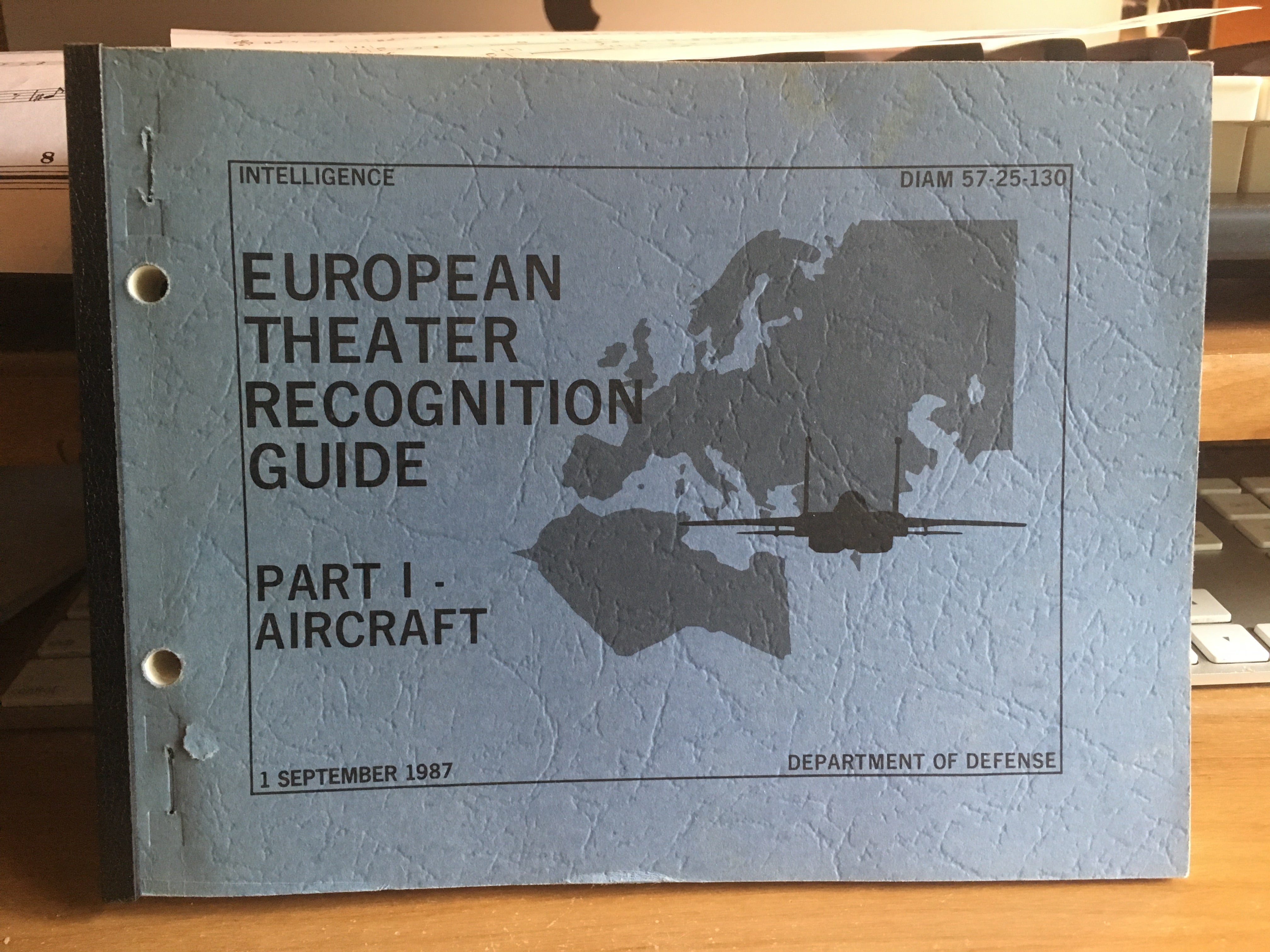
My brother got this for me when he was in the Army stationed in Würzburg back in the day.
 user314
> ttyymmnn
user314
> ttyymmnn
04/20/2018 at 17:27 |
|
This one:
